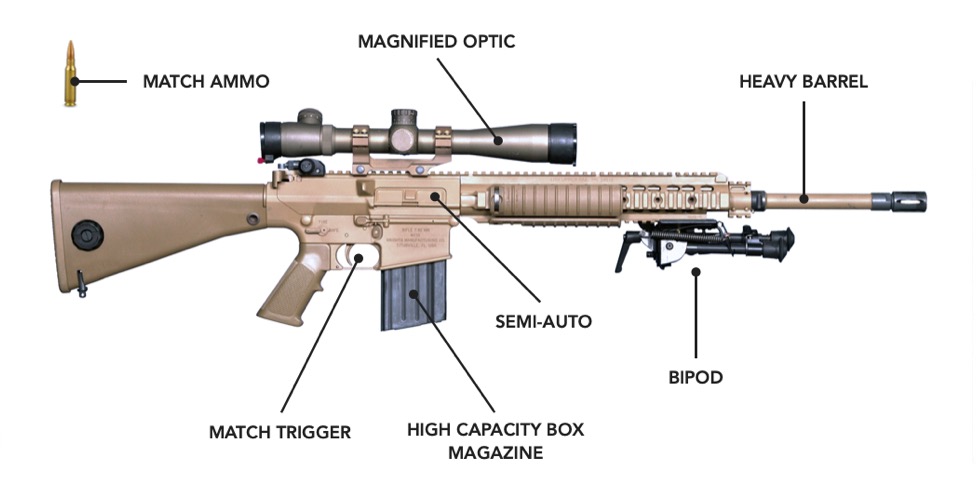While the designated marksman rifle (DMR) is a military rifle issued to sharpshooters or designated marksmen, I have noticed in recent years that they are becoming increasingly popular amongst civilian gun owners.
But what exactly is a DMR, and what singles one out from its counterparts?
Simply put, a DMR is a scoped rifle that is capable of accurately engaging targets at further distances than a standard issue military rifle, which should have semi-automatic capability with a high rate of fire and a detachable box magazine, capable of engaging targets up to and often beyond 600 meters.
There is currently no actual written definition as to what classifies a rifle as a DMR, but general consensus amongst experienced shooters is that while a DMR should have certain features to it, such as those mentioned above, the application of the rifle’s use also contributes towards its peculiarity.
Now let’s dig a little deeper into the DMR, comparing the differences between a standard rifle, a DMR, and a sniper rifle, and who would benefit most from using a designated marksman rifle over something else.
What Makes a Designated Marksman Rifle Unique?

While a DMR may look very similar to a standard issue rifle in may ways, commonly built around AR15 and AR10 platforms, there are certain features that are unique to the DMR, giving the rifle the ability to outperform its standard issue counterpart.
- Magnified Optic – all designated marksman rifles will have some type of optical sight with a higher magnification level than the standard issue rifle, but not quite as powerful as a sniper scope. The low power variable (LPV) scope has recently become popular amongst DMR users, and typically features a 1-6 magnification.
- Heavy Barrel – although not always the case, the DMR often features a slightly longer and heavier barrel, sometimes up to 20-inches in length. The added weight increases consistency between shots, while the extra length increases the rifle’s effective range.
- Action – all modern designated marksman rifles use a semi-automatic action, with some also being able to fire in full-automatic mode. This is vital for laying down a rapid rate of fire when needed, particularly at closer distances.
- Caliber & Ammunition – a DMR is most often chambered in the same caliber as that of the standard issue rifle being used at the time. This allows for interchangeability of ammunition between the marksman and the rest of his team. The most common configurations fire the 5.56x45mm or 7.62x51mm NATO cartridges. There are others such as the 6.5 Creedmoor, .300WinMag, 7.62x54mmR and so on. While the ammo is interchangeable, the marksman himself will most often use a heavier bullet and higher quality match ammunition in his DMR.
- Box Magazine – the box magazine is commonly found in 10, 20, 25 or 30-round capacity and is vital for that rapid rate of fire. A bolt-action rifle would be too slow when fighting in close quarters.
- Trigger – a DMR should be fitted with a precision trigger, which breaks at a far lighter weight than a standard mil-spec trigger, typically between 3.5 to 6.0-lbs.
- Bipod – a high quality swivel bipod is usually fitted to provide a readily available support platform for the shooter.
Who Would use a Designated Marksman Rifle?
When it comes to military use, a DMR is most often issued to a designated marksman, a sharpshooter, or a sniper. Let’s describe these roles in a little more detail.
Note: these roles can differ in definition from one military or regiment to the next, but we will try to explain as best we can.
- Designated Marksman – someone who qualifies with top scores in rifle marksmanship.
- Sharpshooter – someone who is highly proficient at firing rifles accurately, but does not hold or require the additional field skills taught to a sniper.
- Sniper – a military marksman who has specialised training in long range marksmanship as well as many other field skills that are necessary to operate independently, often behind enemy lines.
Although DMR’s may be issued to snipers as well (mission dependant), the role was intended to fill the gap between a regular infantryman and a sniper, and is often issued to a team member who has proven to be a better shot than the rest.
- Regular Infantryman – generally trained to engage targets up to 300, and in some cases 400 meters.
- Designated Marksman or Sharpshooter – capable of accurately engaging targets up to 600 meters, and often further. The person filling this role will attach himself to the infantry unit, adding this extended range capability should it be needed.
- Sniper – capable of engaging targets at much further distances, with great accuracy and often from concealed positions. They will often be detached from their unit, operating in small teams and providing overwatch when required.
As we now know, the DMRs purpose is to integrate into an infantry unit, and therefore requires similar characteristics to the standard issue service rifle, but with the extended range capability. For this reason, the DMR should be a semi-automatic rifle (which may have full-auto capability), which has a high rate of fire and can carry a large ammunition capacity, and is able to effectively engage targets in close quarters all the way out to longer distances extending those of the standard issue rifle.
A bolt-action rifle does not make a good designated marksman rifle, simply because it does not have the high rate of fire required to effectively operate in close quarters.
How Accurate Should a Designated Marksman Rifle be?
While a sniper rifle will be capable of sub-MOA accuracy, it is acceptable for a DMR to drop below to a 1.5-MOA capability out to the rifle’s effective range. This means that a DMR should at minimum, be able to achieve 26cm or 10-inch groups at a distance of 600 meters.
Many DMRs however are capable of sub-MOA groupings, specifically those owned by civilians who develop custom cartridges to achieve the highest level of performance from their rifle.
The Designated Marksman Rifle vs. The Sniper Rifle
| Designated Marksman Rifle | Sniper Rifle |
| Build for accuracy, with a high rate of fire | Built for single round precision |
| Often uses the same caliber as the standard issue rifle | May feature large, powerful calibers |
| Semi-automatic rifle which may have full-auto capability | Most commonly a bolt-action rifle, but may be semi-auto in some cases |
| Low to medium power optic | Medium to High power optic |
| Optimised for targets up to 800 meters | Optimised for engaging targets beyond 800 meters |
| Very effective at close range | Slow and cumbersome at close range |
What is the Best Caliber for a DMR?
While there are a variety of calibers that make excellent DMRs, the choice often comes down to the 5.56×45 or 7.62x51mm NATO cartridge, due to the availability of ammunition to both military personnel and civilians.
Advantages of the 5.56x45mm Cartridge:
- Often accepts .223 Remington cartridges
- Higher magazine capacity, typically 30-rounds
- Lighter rifle and ammunition
- Cheaper cost of both the rifle and ammunition
- Lower recoil, which increases accuracy during follow-up shots
Advantages of the 7.62x51mm Cartridge:
- Often accepts .308 Winchester cartridges
- Recoil is moderate, but the bullet is heavier and less affected by wind
- Superior penetration and stopping power
- Longer accurate barrel life
If your goal is to build a DMR with the longest range capability, then there are superior bullets to those listed above, such as the 6.5 Grendel, 6.5 Creedmoor, .300 Winchester Magnum, and so on.
While these bullets may extend the rifle’s effective range by up to 30-percent, with excellent external ballistic performance, the availability of ammunition in the prepper’s perspective may be an issue. For this reason, DMRs are typically built around calibers that are commonly found throughout the national military and police service, such as the 5.56 and 7.62mm NATO cartridges.
Final Thought
The designated marksman rifle is clear in its role amongst military personnel, but with many civilian gun owners turning their attention towards DMR builds, the choice on which rifle to purchase and which caliber to select can often be overwhelming.
To simplify this for you, my advice would be to follow the most abundant intermediate or full-power battle cartridge available in your province or country; especially if the rifle’s use includes survival. In this case, a barrel length between 16 and 20-inches would be ideal.
If long range precision is your deciding factor, then explore other cartridge options such as the 6.5 Creedmoor. But whichever choice you make, you’r almost guaranteed to find the DMR to be tons of fun, whether engaging multiple targets at close range, or making precision shots out to 1000 meters, with the right bullet of course.


2 thoughts on “What is a Designated Marksman Rifle [or DMR]”